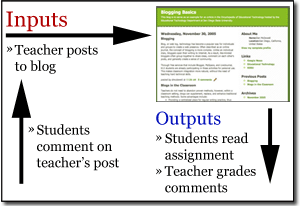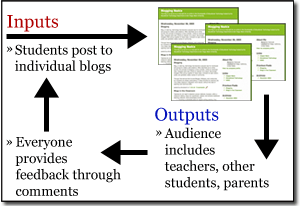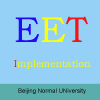-
Blogging techniques for the K12 classroom
普通类 -
- 支持
- 批判
- 提问
- 解释
- 补充
- 删除
-
-
Blogging techniques for the K12 classroom
WHILE THE CONCEPT OF BLOGGING has entered the mainstream, many teachers do not know about specific implementation strategies. This article will focus on four core methods to use blogs with students and help teachers address the logistical factors involved.
-
Blogging overview
Figure 1: This diagram represents a basic blog, to read about the different components, roll your cursor about the pink circles.
Blog, or web log, technology has become a popular way for individuals and groups to create a web presence. Often described as an online journal, the concept of blogging is more complex. Unlike an individual diary, bloggers open their writing to Internet. As a result, like-minded bloggers often group together to share ideas, comment on each other’s posts, and generally create a sense of community.
Through free services that include Blogger, MySpace, and LiveJournal, K12 students are already participating in these activities for personal use. This makes classroom integration more natural, without the need of teaching hard technical skills.-
Blogs in the classroom
Teachers do not need to abandon proven methods, however, within a classroom setting, blogs can supplement, replace, and enhance traditional teaching methods. Some advantages include:
Providing a centralized place for regular writing practice, thus eliminating the need to collect multiple papers from each student.
Allowing the teacher and other students to comment and provide feedback on individual posts.
Creating a greater sense of community within a class that will more deeply permeate into their personal lives.
Giving a voice to students who may not feel comfortable speaking aloud in a classroom setting or who are overshadowed by the more vocal students.
Blogs are a simple tool that can be molded to the specific instructional needs of the teacher. Sample activities include analysis of information for bias, reflections on classroom readings, reporting on classroom or current events, portfolio creation, sharing of resources, or use as a final product within a WebQuest.-
Blogs as classroom tools
While there are numerous lesson types that use blogs, the bigger question becomes how does a teacher actually use a blog (or blogs) with his/her students. The actual technology (i.e. Blogger) is relatively simple to set up and administer. However, the structure and logistics need to be considered and part of the planning process. Without delving into the pedagogy, the following descriptions explain methods for implementation.
-
Blogs as an administration tool

Figure 2: This diagram represents the use of blogs as a one-way communication device.
Often teachers wish to publish a classroom web page, but lack the technological skills or time to create a traditional html-based web page. Setting up a web page as a blog is quick and easy. Furthermore, editing and adding content is equivalent to using a web-based e-mail account. A classroom blog can provide students and parents with due dates, assignments, links, and other important classroom information. For this type, the only contributor is the instructor. The instructor posts to the blog and the students read the post and complete the necessary actions.
Examples: Mrs. Nelson's 5th Grade Class, Mr. McDowell's World History, Elizabeth Fullerton.comBlogs as a discussion tool

Figure 3: A representation of the first use of blogs as a discussion tool.

Figure 4: A representation of the second use of blogs as a discussion tool.Discussions are central to many classes. Discussion boards have long been available to teachers, but threaded discussions are more difficult to navigate and track. The simple, linear nature of blogs can simplify online classroom discussions. Blogs allow teachers to bring the topics beyond the confines of the classroom and expand the discussion to include all students in a given class. Using a single blog, there are two possibilities.
The first method involves the teacher posting a question, quote, or other piece of information in the blog. Students read the prompt and post a comment. At the end of the assignment the teacher reviews the comments on the post.
Examples: Mrs. Lowe's Class
In the second method, teachers grant access to students to post to a class blog, as well as, post comments. The assignment for this set up needs to be more complex then responding to a single question, otherwise the blog will be populated with similar responses. The sharing of resources and the jigsawing of complex subjects fit well into this method. It also provides a chance for students to receive direct feedback in the form of comments on their posts.
Examples: Pre-Cal 30S, The Secret Life of Bees, In Need of Coffee-
Blogs as a Publication Tool

Figure 5: Here students have their own blogs, which the teachers track.
With this final method, each student is provided his/her own blog. They can be tied together into a community setting, with each blog linking to the others. Or, they can all be linked from a common page. Assignments range from short-term projects, a classroom newspaper, a digital portfolio, or ongoing reflections to the topics being studied in class. The teacher tracks student posts and makes comments when appropriate. Other students can be assigned the task of reading posts and making comments. Based upon the comments, the students could edit posts before a final due date.
Examples: Blog Write, Brandon's Online Magazine, East Side Bloggers, Immigration Experience (A project from the Immigrant Experience Journal WebQuest)-
Logistical Considerations
Once you have decided upon an activity and method of implementation, teachers must set up the nature and structure of the system. There are a number of free blogging services available (including Blogger, Edublogs, and Schoolblogs). However, teachers can expand their flexibility by using a pay service (Typepad) or by installing an open source system (OpenSourceCMS.com) onto a school or personal server. If privacy is an issue, a password-protected system (Typepad or a CMS) will be necessary.
Once a teacher has determined the specific blog application, he/she must assign access to students. All blogs allow the users to determine who may post and can even limit who is allowed to comment. These functions will allow the blog to remain in the instructor’s control, without hindering the public nature of a blog.
If allowing students to set up their own blog with a non-school service, teachers must be aware that they or their district cannot control student access or content.
Tracking student posts can be cumbersome, especially for middle and high school teachers. Blogs generally come with a Really Simple Syndication (RSS) or Atom feed that teachers may track through their browser or through a third party service (Bloglines). These feeds will indicate if the blogs has been updated and provide part or the entire post.-
More Information
Use of blogs in online college classes
Weblogs in education
Blogs and wikis as WebQuest Tasks-
Author
Dan McDowell
McDowell, D. (2004). Blogging in the K12 classroom. In B. Hoffman (Ed.), Encyclopedia of Educational Technology. Retrieved July 16, 2010 -
-
- 标签:
- 12
- blogging
- blogs
- students
- classroom
- discussion
- blog
- k12
- posts
- teacher
- post
- web
- techniques
- teachers
-
加入的知识群:



学习元评论 (0条)
聪明如你,不妨在这 发表你的看法与心得 ~